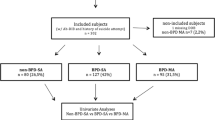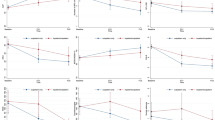Abstract
This article examines a large cohort of previously suicidal adolescents, identifying those that surpassed threshold criteria for borderline personality disorder (BPD), according to the Abbreviated Diagnostic Interview of Borderlines (Ab-DIB), and determining the stability, correlates and predictors of BPD from early-to-late adolescence. Two hundred and eighty-six youth (mean baseline age 14.6 years; SD 1.5), presenting consecutively to a metropolitan pediatric hospital emergency department for evaluation of suicidality, were assessed at initial consultation for Axis I and II disorders and demographic and clinical variables. Two hundred and twenty-nine (80 %) were re-assessed for those variables 4 years later and 204 (70.3 %) had complete data sets at recruitment and follow-up. Previously suicidal youths who met BPD threshold on the Ab-DIB at recruitment were distinguishable at baseline from those who did not in conduct disorder symptoms (p < 0.003), lower levels of functioning (p < 0.001), drug use (p < 0.001), stressful life events (p < 0.003) and family relations (p < 0.001). The BPD diagnosis was consistent, according to this measure, at baseline and follow-up for 76 % of participants. Four groups with respect to borderline pathology (persisting, remitting, emerging and never) were identified (ICC = 0.603, 95 % CI = 0.40–0.78). Persistent BPD status was predictable by older age at presentation (p < 0.01) and level of functioning (p < 0.05). Eight percent were also suicidal at the 4-year follow-up. Using a self-report measure of BPD, we suggest that suicidal youth can indeed be diagnosed with the disorder at 14 years old, supporting the shift from DSM-IV to DSM-5, given what appears to be its temporal stability, differentiation of those suffering with considerable symptomatology or not, and predictors of its status in late adolescence. The low suicidality rate at follow-up indicates a good short-term prognosis.
Similar content being viewed by others
References
National Institute of Mental Health (NIMH). Signs and Symptoms. http://www.nimh.nih.gov/health/topics/borderline-personality-disorder/index.shtml#part3
American Psychological Association. Diagnostic and statistical manual of mental health disorders. Vol 5th ed. Arlington, VA. American Psychological Association; 2013
Yen S, Gagnon K, Spirito A (2013) Borderline personality disorder in suicidal adolescents. Personal Ment Health 7(2):89–101
Miller AL, Muehlenkamp JJ, Jacobson CM (2008) Fact or fiction: diagnosing borderline personality disorder in adolescents. Clin Psychol Rev 28(6):969–981
Hall GS (1904) Adolescence: Its psychology and its relation to physiology, anthropology, sociology, sex, crime, religion, and education, Vols. I, II, Prentice-Hall, NJ.
Ludolph PS, Westen D, Misle B, Jackson A, Wixom J, Wiss FC (1990) The borderline diagnosis in adolescents: symptoms and developmental history. Am J Psychiatry 147(4):470–476
Kasen S, Cohen P, Skodol AE, Johnson JG, Brook JS (1999) Influence of child and adolescent psychiatric disorders on young adult personality disorder. Am J Psychiatry 156(10):1529–1535
Zanarini MC, Frankenburg FR, Hennen J, Reich DB, Silk KR (2004) Axis I comorbidity in patients with borderline personality disorder: 6-year follow-up and prediction of time to remission. Am J of psychiatry 161(11):2108–2114
Levy KN, Becker DF, Grilo CM et al (1999) Concurrent and predictive validity of the personality disorder diagnosis in adolescent inpatients. Am J Psychiatry 156(10):1522–1528
Chen H, Cohen P, Johnson JG, Kasen S, Sneed JR, Crawford TN (2004) Adolescent personality disorders and conflict with romantic partners during the transition to adulthood. J Pers Disord 18(6):507–525
Gunderson JG, Stout RL, McGlashan TH, Shea MT, Morey LC, Grilo CM, Zanarini MC, Yen S, Markowitz JC, Sanislow C, Ansell E, Pinto A, Skodol AE (2011) Ten-year course of borderline personality disorder: psychopathology and function from the collaborative longitudinal personality disorder study. Arch Gen Psychiatry 68(8):827–837
Zanarini MC, Frankenburg FR, Reich DB, Silk KR, Hudson JI, McSweeney LB (2007) The subsyndromal phenomenology of borderline personality disorder: a 10-year follow-up study. Am J Psychiatry 164(6):929–935
Grant BF, Chou SP, Goldstein RB et al (2008) Prevalence, correlates, disability, and comorbidity of DSM-IV borderline personality disorder: results from the wave 2 national epidemiologic survey on alcohol and related conditions. J Clin Psychiatry 69(4):533–545
Bernstein DP, Cohen P, Velez CN, Schwab-Stone M, Siever LJ, Shinsato L (1993) Prevalence and stability of the DSM-III-R personality disorders in a community-based survey of adolescents. Am J Psychiatry 150(8):1237–1243
Chanen AM, Jovev M, Djaja D et al (2008) Screening for borderline personality disorder in outpatient youth. J Pers Disord 22:353–364
Paris J (2002) Chronic suicidality among patients with borderline personality disorder. Psychiatr Serv 53(6):738–742
Statistics Canada. Suicides and suicide rate, by sex and by age group (2009). http://www40.statcan.gc.ca/l01/cst01/hlth66a-eng.htm
Centre for Disease Control and Prevention. National Centre for Injury Prevention and Control. Web-based Injury Statistics Query and Reporting System (WISQARS) (2012). http://www.cdc.gov/ncipc/wisqars
Greenfield B, Larson C, Hechtman L, Rousseau C, Platt R (2002) A rapid-response outpatient model for reducing hospitalization rates among suicidal adolescents. Psychiatr Serv 53(12):1574–1579
Canadian Institute of Health Research (2005) Tri-council policy statement: Ethical conduct for research involving humans.
Greenfield B, Henry M, Weiss M, Tse SM, Guile JM, Doughtery G, Zhang X, Fombonne E, Lis E, Lapalme-Remis S, Harnden B (2008) Previously suicidal adolescents: predictors of six-month outcome. J Can Acad Child Adolesc Psychiatr 17(4):197–201
Shaffer D, Gould MS, Brasic J et al (1983) A children’s global assessment scale (CGAS). Arch Gen Psychiatry 40(11):1228–1231
Costello AJ, Edelbrock CS, Dulcan MK, Kalas R, Klaric S (1984) Report on the NIMH diagnostic interview schedule for children (DISC). National Institute of Mental Health, Rockville
Schwab-Stone ME, Shaffer D, Dulcan MK et al (1996) Criterion validity of the NIMH diagnostic interview schedule for children version 2.3 (DISC-2.3). J Am Acad Child Adolesc Psychiatry 35(7):878–888
Pfeffer CR, Conte HR, Plutchik R, Jerrett I (1979) Suicidal behavior in latency-age children: an empirical study. J Am Acad Child Psychiatry 18(4):679–692
Pfeffer CR, Klerman GL, Hurt SW, Lesser M, Peskin JR, Siefker CA (1991) Suicidal children grow up: demographic and clinical risk factors for adolescent suicide attempts. J Am Acad Child Adolesc Psychiatry 30(4):609–616
Coddington RD (1972) The significance of life events as etiologic factors in the diseases of children. II. A study of a normal population. J Psychosom Res 16(3):205–213
Hudson WW (1982) The clinical measurement package: a field manual. Dorsey Press, Homewood
Corcoran KJ, Fischer J (1987) Measures for clinical practice: a sourcebook. Free Press, New York
Zanarini MC, Gunderson JG, Frankenburg FR, Chauncey DL (1989) The revised diagnostic interview for borderlines: discriminating BPD from other axis II disorders. J Pers Disord 3(1):10–18
Guile JM, Greenfield B, Berthiaume C, Chapdelaine C, Bergeron L (2009) Reliability and diagnostic efficiency of the abbreviated-diagnostic interview for borderlines in an adolescent clinical population. Eur Child Adolesc Psychiatry 18(9):575–581
Guile GM, Bergeron L, Berthiaume C, Greenfield B, Breton JJ, Valla JP (2006) Construct validity and normed profiles of the Abbreviated Diagnostic Interview for Borderlines (Ab-DIB) in young adolescents. In: 53rd Annual Meeting of the American Academy of Child and Adolescent Psychiatry, San Diego, Oct 24–29.
Rodriguez GE, Elo I (2003) Intraclass correlation in random-effects models for binary data. Stata J 1(3):32–46
Stata Statistical Software: Release 10 (computer program) (2007) College Station, TX: StataCorp LP.
Winograd G, Cohen P, Chen H (2008) Adolescent borderline symptoms in the community: prognosis for functioning over 20 years. J Child Psychol Psychiatry 49(9):933–941
Bornovalova MA, Hicks BM, Lacono WG, McGue M (2009) Stability, change, and heritability of borderline personality disorder traits from adolescence to adulthood: a longitudinal twin study. Dev Psychopathol 21(4):1335–1353
Mattanah JJ, Becker DF, Levy KN, Edell WS, McGlashan TH (1995) Diagnostic stability in adolescents followed up 2 years after hospitalization. Am J Psychiatry 152(6):889–894
Meijer M, Goedhart AW, Treffers PDA (1998) The persistence of borderline personality disorder in adolescence. J Pers Diso 12(11):13–22
World Health Organization (1992) The ICD-10 classification of mental and behavioral disorders: clinical descriptions and diagnostic guideline World Health Organization Staff. World Health Organization, Albany
Stone MH (1990) The fate of borderline patients: successful outcome and psychiatric practice. Guilford Press, New York
Paris J, Zweig-Frank H (2001) A 27-year follow-up of patients with borderline personality disorder. Compr Psychiatry 42(6):482–487
Kaufman J, Birmaher B, Brent D, Rao U, Flynn C (1997) Schedule for affective disorders and schizophrenia for school-age children- present and life-time version (K-SADS-PL): initial reliability and validity data. J Am Acad Child Adolesc Psychiatry 36(7):980–988
Westen D, Shedler J (2000) A prototype matching approach to diagnosing personality disorders: toward DSM–5. J Pers Disord 14:109–126
Acknowledgements
The Hogg Family Foundation and The Montreal Children’s Hospital Foundation.
Conflict of interest
None.
Author information
Authors and Affiliations
Corresponding author
Rights and permissions
About this article
Cite this article
Greenfield, B., Henry, M., Lis, E. et al. Correlates, stability and predictors of borderline personality disorder among previously suicidal youth. Eur Child Adolesc Psychiatry 24, 397–406 (2015). https://doi.org/10.1007/s00787-014-0589-9
Received:
Accepted:
Published:
Issue Date:
DOI: https://doi.org/10.1007/s00787-014-0589-9




